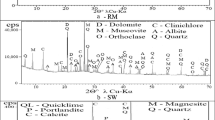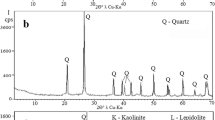Abstract
This paper reports the development and characterization of new ceramics from hazardous bauxite red mud (50 to 100 wt. %) and blast furnace slag (10 and 50%). The research aimed to demonstrate the possibility of expanding the base of powder raw materials for production of ceramics, completely replacing the traditional clay and sand with composites made from hazardous industrial wastes, which provide increasing local and global sustainability. The investigation of the physical–chemical changes in the ceramics structure was conducted by the AAS, XRD, SEM, XRF, LAMMA, and EDS tests. Changes in water absorption, density, linear shrinkage, and flexural strength were determined while the sintering processes ranged from 1000° to 1225 °C. Flexural strength reached 19.78 MPa after sintering at 1225 °C due to the syntheses of new structure formations, mainly similar to glass, confirmed by the characterization methods used, attesting to the complete binding of heavy metals.





Similar content being viewed by others
Data availability
The raw/processed data required to reproduce these findings cannot be shared at this time as the data also forms part of an ongoing study.
References
Hawking SW. http://www.independent.co.uk/news/science/stephen-hawking-pollution-stupidity-artificial-intelligence-warfare-biggest-threats-mankind-a7106916.html. Accessed 28 June 2016.
World Aluminum. Primary Aluminum Production. http://www.world-aluminium.org/statistics/#linegraph. Accessed 22 Jan 2018.
Hungary (2018) https://www.google.com.br/search?q=Hungaria+ecological+tragedy+2010&tbm=isch&tbo=u&source=univ&sa=X&ved=0ahUKEwjg7rTGjI3ZAhUJEJAK HeP8DxIQsAQIKg&biw=1813&bih=830#imgrc=endIlYzzpvAZ4M:
Sushil S, Batra VS (2008) Catalytic applications of red mud, an aluminum industry waste: a review. J Appl Catalysis B: Environ 81:1
Liu W et al (2009) Review on treatment and utilization of bauxite residues in China. Int J Miner Proc 3:220–231
Deihimi N et al (2018) Characterization studies of red mud modification processes as adsorbent for enhancing ferricyanide removal. J Env Man 206:266–275. https://doi.org/10.1016/j.jenvman.2017.10.037
Barthoda J et al (2018) Adding worms during composting of organic waste with red mud and fly ash reduces CO2 emissions and increases plant available nutrient contents. J Environ Man 222:207–215. https://doi.org/10.1016/j.jenvman.2018.05.079
Dodoo-Arhin D et al (2013) Fabrication and characterization of Ghanaian bauxite red mud-clay composite bricks for construction applications. Am J Mat Sci 3:110–119
Liu Y, Naidu R (2014) Hidden values in bauxite residue (red mud): recovery of metals. J Was Man 34:2662–2673. https://doi.org/10.1016/j.wasman.2014.09.003
Pontikes Y, Angelopoulos GN (2013) Bauxite residue in cement and cementitious applications: current status and a possible way forward. J Res Con Rec 73:53–63
Qaidi S et al (2022) Sustainable utilization of red mud waste (bauxite residue) and slag for the production of geopolymer composites. J Case St Con Mats 16:e00994. https://doi.org/10.1016/j.cscm.2022.e00994
de Azevedo ARG et al (2022) Perspectives for the application of bauxite wastes in the development of alternative building materials. J Mat Res Tech 20:3114–3125. https://doi.org/10.1016/j.jmrt.2022.08.092
ISSUU (2017) Iron and steel slags: global perspective on the circular economy. https://issuu.com/hbmgroup/docs/2017_heidrich_etal
Lukowski P, Salih A (2015) Durability of mortars containing ground granulated blast-furnace slag in acid and sulphate environment. J Pro Eng 108:47–54. https://doi.org/10.1016/j.proeng.2015.06.118
Barreto LSS et al (2020) Reuse of ornamental rock-solid waste for stabiliza ti on and solidification of galvanic solid waste: optimization for sustainable waste management strategy. J Clean Prod 275:122996. https://doi.org/10.1016/j.jclepro.2020.122996
El-Ashtoukhy E-SZ et al (2020) Intensification of a new electrocoagulation system E.-S. Z. characterized by minimum energy consumption and maximum removal efficiency of heavy metals from simulated wastewater. J Chem En Proc–Proc Inten 154:108026. https://doi.org/10.1016/j.cep.2020.108026
Kołodyńska D et al (2020) Evaluation of possible use of the macroporous ion exchanger in the adsorption process of rare earth elements and heavy metal ions from spent batteries solutions. J Chem Eng Proc Proc Intens. 147:107767. https://doi.org/10.1016/j.cep.2019.107767
Jordán MM et al (2022) Technological and environmental behaviour of traditional ceramic bodies obtained by recycling of two types of residues. J Coatings 12:221. https://doi.org/10.3390/coatings12020221
Jordán MM et al (2021) Technological behaviour and leaching tests in ceramic tile bodies obtained by recycling of copper slag and MSW fly ash wastes. J Mat Cyc Waste Man. https://doi.org/10.1007/s10163-020-01162-8
Mymrin V et al (2005) Structure formation of slag-soil construction materials. J Mat Str 38:107–113. https://doi.org/10.1007/BF02480582
Ding L et al (2015) Preparation and characterization of glass–-ceramic foams from blast furnace slag and waste glass. J Mat Let 14:327–329. https://doi.org/10.1016/j.matlet.2014.11.122
Ma.Rincón J (2018) Vitrification and derived glass-ceramics from mining wastes containing vermiculite and lithium aluminium phosphate. J Mat Lett 227:86–89. https://doi.org/10.1016/j.matlet.2018.05.001
NBR 10,004 (2004) Solid waste classification, Rio de Janeiro
Johnson DW, Gallagher PK (1971) Kinetics of the decomposition of freeze-dried aluminum sulfate and ammonium aluminum sulfate. J Amer Ceram Soc 54:461–465. https://doi.org/10.1111/j.1151-2916.1971.tb12386.x
Kato E, Daemon K, Nanbu M (1981) Decomposition of two aluminum sulfates and characterization of the resultant aluminas. J Am Cer Soc 64:436–443. https://doi.org/10.1111/j.1151-2916.1981.tb09892.x
Kimjashov AA (2010) Phase equilibria in systems Fe - Al - O and Fe - Si - O in the temperature range 1100 - 1300 K, Dissertation, South Ural State University, Chelyabinsk,. https://www.susu.ru/abstract/file/abstract/kimjashov_alexander_anatoljevich.docx
NBR 15270 (2005) Ceramic components, part 2: ceramic blocks for structural masonry and sealing - terminology and requirements, Rio de Janeiro.
Brown ME, Gallagher PK (2011) Handbook of thermal analysis and calorimetry: recent advances, techniques and applications. Elsevier
Balesteros S et al (2017) Vitrification of urban soil contamination by hexavalent chromium. J Gexplo 174:132–139. https://doi.org/10.1016/j.gexplo.2016.07.011
Rincón-Mora B et al (2016) Chromium oxide additions in lithium disilicate glass crystallization. J Mater Lett 179:138–141. https://doi.org/10.1016/j.matlet.2016.05.061
Acknowledgements
The authors are thankful to the staff of the Laboratory of Minerals and Rocks (LAMIR) of the Federal University of Paraná (UFPR), Curitiba, Brazil, for their strong technical assistance during this research.
Author information
Authors and Affiliations
Contributions
All co-authors meet criteria for authorship and ensure appropriate acknowledgements made in the manuscript: VM—author of the idea, developer of the plan of the experiments, participant of all stages of the research, corresponding author. KA—performer of LAMMA analyses, co-author of this manuscript. WK – sintering of the test samples. DEP—bibliographical revision and performer of XRD analyses. CLP—bibliographical revision and performer of SEM analyses. FHP—performer of all types of laboratory experimental works, co-author of this manuscript. KQC – performer of all laboratory experimental works, co-author of this manuscript. CWIH—performer of all types of laboratory experimental works, ceramics’ sintering, co-author of this manuscript. REC—bibliographic studies, performer of all types of laboratory experimental works, co-author of this manuscript.
Corresponding author
Ethics declarations
Conflict of interest
No potential conflict of interest was reported by the authors.
Human and animal participants
We had no clinical trials and research using animals. We can sign a copyright agreement.
Informed consent
We show informed consent and provide assurances that participants’ rights are protected.
Consent for publication
Declare that our manuscript was not published and not submitted elsewhere.
Additional information
Publisher's Note
Springer Nature remains neutral with regard to jurisdictional claims in published maps and institutional affiliations.
Rights and permissions
Springer Nature or its licensor (e.g. a society or other partner) holds exclusive rights to this article under a publishing agreement with the author(s) or other rightsholder(s); author self-archiving of the accepted manuscript version of this article is solely governed by the terms of such publishing agreement and applicable law.
About this article
Cite this article
Mymrin, V., Alekseev, K., Klitzke, W. et al. Hazardous bauxite red mud and ferrous slag management to produce sustainable construction materials. J Mater Cycles Waste Manag 25, 1549–1559 (2023). https://doi.org/10.1007/s10163-023-01629-4
Received:
Accepted:
Published:
Issue Date:
DOI: https://doi.org/10.1007/s10163-023-01629-4




